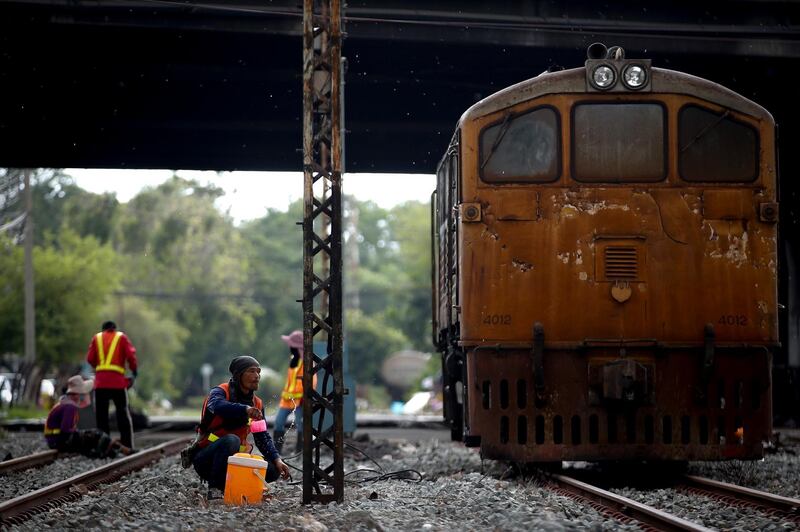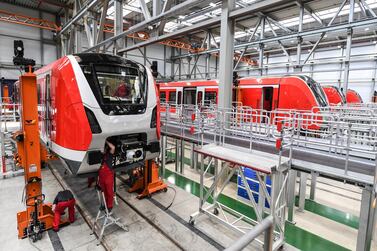A city famous for traffic jams is looking to solve its congestion and pollution woes by building a massive train station and overhauling its rail network.
Bangkok, a capital choked by daily gridlock and seasonal toxic haze, is at the centre of plans for Thailand’s biggest rail development project that will make travel by train possible to China and Singapore, and will connect most major Thai cities to Bangkok and its expanding transit systems.
The Thai government has committed to spending more than $21 billion (Dh77.1bn) to expand Bangkok’s rail transit, extend train lines, and build high-speed rails -- with a massive $1.3bn hub at the centre that will become Southeast Asia’s largest train station when it opens in 2021.
The plan is part of the government’s move to ease air pollution. Exhaust from gas guzzling vehicles, as well as power generators, has been blamed for contributing to hazardous haze blanketing Bangkok and parts of the country over the past several months. The government has urged citizens to use more public transportation and has made expanding the transit system a priority.
“It will be good for the country’s economy and environment over the long term,” said Somprawin Manprasert, chief economist at Bank of Ayudhya. “The pollution problem has shown that we have reached the point where our actions start to hurt us.”
Thailand’s rail ambition serves not only as a tool to reduce fossil fuel use but also to boost the struggling economy, overhaul its dated train system and tame its currency. The rail network is a flagship infrastructure project that’s viewed as a major support for an economy reeling from a severe drought and a slump in tourism as a result of the coronavirus outbreak.
The majority of the $33bn infrastructure budget over the next three years will be spent on rail projects, with the goal that it will bring more private investment and boost consumption as Thailand seeks to recover from the slowest growth in five years.
“The global economy is quite weak and the interest rates are quite low. This is the best time to invest in infrastructure,” Voravuth Mala, acting governor of the State Railway of Thailand, said in an interview. “If people can travel quickly and conveniently, the economy will be good. That’s the idea we build upon.”
The development will double the state passenger rail’s capacity and triple the freight capacity through track doubling. It’s expected to serve more than 22 million commercial passengers annually after the upgrade, and transport more than 30 million tonnes of commodities. High-speed rail will connect key Thai cities to Bangkok, a city of 10 million residents and 20 million visitors where the transit system will also double in number of lines.
Even though Chinese and Japanese rail systems dwarf that of Thailand, such expansion is rare for the country, where the network had been undeveloped for almost seven decades as it turned to highways. The state rail network reached 3,300 kilometres in 1951, but has only added about 700km over the past 69 years.
“Investing in the rail system is necessary for economic development,” said Pavida Pananond, an associate professor at Thammasat Business School’s Department of International Business, Logistics and Transport. “But the caveats for Thailand lie in the usual issue of how these projects are implemented, whether it will be a source of vested interests in corruption and siphoning off the budget.”
For Mr Voravuth, who has been at the rail agency for three decades, he’s now starting to see the projects that were discussed during his early years come to fruition. By 2037, the network length is expected grow by 60 per cent with routes added to tourist destinations and border towns.
The double-track rails will make transportation of goods and passengers more efficient and reduce logistics costs in the country, said Manoj Lohatepanont, director of Chulalongkorn University Transportation Institute. However, high-speed rails will not see enough demand for at least a decade, and the government still needs to develop suitable feeder systems for Bangkok transit to increase usage, he said.
Thailand’s first high-speed rail will connect to the Chinese rail network at Vientiane, the capital city of Laos. It will be built by China, and will become part of the Belt and Road Initiative. It will also serve a purpose of taming the baht, which has strengthened last year partly because of a healthy current account and large foreign-cash pile.
The contract with the Chinese counterpart will be expressed in US dollars, said Kobsak Pootrakool, secretary of the Economic Ministers Council. “Buying a large amount of dollars on the day of contract signing will weaken the baht and reverse the flow,” he said, adding that it’s the first time the Thai government has used dollars as currency in the contract, though it could become more common in the future.
The first phase of the 608km rail network is already under construction. The second phase, which would connect to the Chinese railway in Laos, is in the design phase. Several high-speed contracts covering 668km and 970km routes are being planned.
When the giant Bangkok station opens in early 2021, the rail agency plans to slowly phase out the old diesel locomotives and replace them with electric trains, according to State Railway’s Mr Voravuth. The idea is in line with the country’s power plan to reduce the share of electricity produced from fossil fuels and increase the amount form renewable sources.







